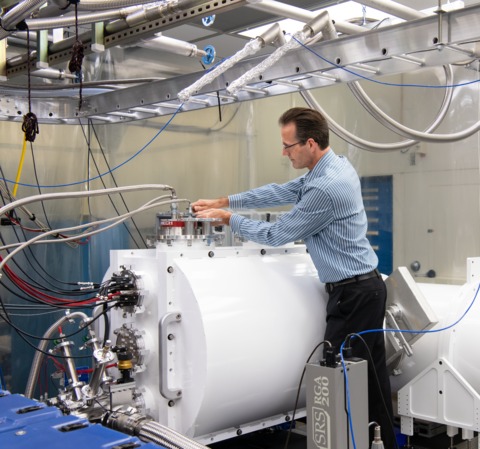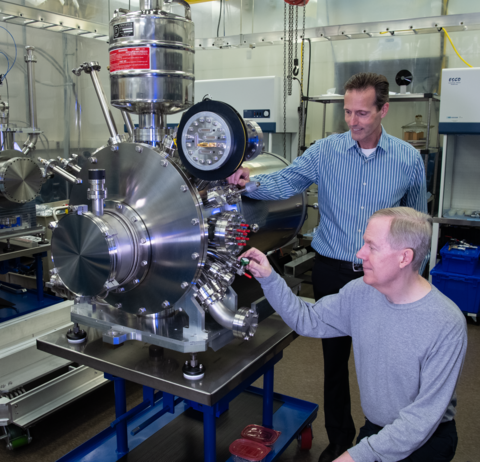
Tim Jung with the new UXR, the next-generation portable radiometer for missile defense-related applications.
If you’re undergoing a missile attack and that missile is above the atmosphere, the best place to destroy it is while it’s still in space. To do that, you need to be confident that the missile interceptors that you launch from Earth are going to hit their target – a very difficult task.
“They say it's like hitting a bullet with a bullet,” said NIST’s Simon Kaplan. “The missile is this little dot which is very far away against the cold background of space, and the military is trying to find it and hit it at very high speed – many kilometers per second.”
Key parts of this interception equipment are infrared sensors, extremely sensitive heat-detecting devices, in the form of telescopes, that are capable of locating the incoming missile. However, since it’s complicated and expensive to conduct all the necessary tests using real rockets, Kaplan said, contractors test their sensors using special chambers in ground-based laboratories.
Each chamber used by the contractors is about the size of a large closet, and it’s cryogenically cooled and also under vacuum in order to mimic the conditions in space. The chambers include a stand-in for the missile being targeted, too – a tiny warm object called a radiation blackbody, which simulates the heat coming from an approaching missile.
But how can contractors be sure that the chambers themselves are really producing the correct environment for their sensors to test?
For more than 30 years, the National Institute of Standards and Technology (NIST) has been assisting with this task.
The portable instrument NIST scientists bring to customers’ chambers is a radiometer, capable of assessing how much warmth is produced by the blackbody in the cryogenic vacuum chamber. This warmth is actually infrared radiation with wavelengths about 10 micrometers (millionths of a meter) long, much longer than the wavelengths of light the human eye can see. (For comparison, visible light has wavelengths between about 0.3 and 0.8 micrometers.)
The device does not measure warmth directly, however. Instead, it measures power. The amount of power coming from a blackbody heat source – whether it’s a light source in a customer’s test chamber, or an incoming missile – has a well-known relationship with its distance from a detector. By measuring the power coming from the source, sensors can gauge its distance away.
When NIST first began making these measurements in the 1980s, Kaplan said, there were many calibration and test facilities around the country and their results didn’t necessarily agree. “So it was a natural thing for NIST to get involved,” Kaplan said. “It helped people have an independent assessment of things.”
MDXR: A Late Introduction

The current model of radiometer NIST employs for this purpose is called the Missile Defense Transfer Radiometer (MDXR), in use since 2010.
The MDXR is about the size of a prize hog. It’s about one meter wide and two meters long, and it weighs roughly 350 kilograms (about 800 pounds). MDXR’s measurements are traceable to a NIST instrument called the Primary Optical Power Radiometer (POWR), which realizes the definition of the watt, the SI unit of power.
Like many radiometers, both POWR and the MDXR make their measurements using the principle of electrical substitution, which involves balancing two kinds of power: one from the incoming light and the other from electricity.
Each radiometer has a small cavity that can absorb all the light hitting it from a source. In front of the cavity is a shutter that can be opened and closed. There is also a heater that can feed additional energy into the cavity.
The cavity is kept at a constant temperature using a feedback loop. When the shutter is open, the radiometer sees the light source and the cavity heats up. To maintain that constant temperature, the amount of power going into the heater goes down.
Then, when the shutter closes, the cavity cools down. To keep the temperature constant, the amount of power going into the heater goes up again.
Measuring power usage when the shutter is open versus closed tells scientists the optical power of the light source.
Though people have been doing electrical substitution measurements for a long time, unlike most other instruments the MDXR makes measurements in low temperature and in vacuum. It’s also looking at very low power levels, on the order of picowatts (trillionths of a watt).
“Most people don't do that kind of measurement because it's time consuming and expensive,” Kaplan said. “It's the kind of thing that NIST does, these fundamental standards for optical radiometry.”
The instruments used to calibrate the MDXR at NIST have uncertainties in the hundredths of a percent. But by the time the MDXR is out in the real world after calibration, it measures power with an accuracy of about 2%. “And that seems to be good enough for the customers,” Kaplan said. “It’s hard to do this kind of infrared radiometry any better than that. We do it as accurately as we can.”
On the Road Again
When a customer needs a chamber calibration, the MDXR and its associated hardware are loaded onto a truck and driven to the customer’s location. Then NIST scientists put the MDXR on a table next to the customer’s chamber and exposes it to the customer’s source. Then NIST scientists measure how much light is coming out of the infrared source, at each wavelength, compared to what the customers expected. This process can take anywhere from two to four weeks, depending on the number of chambers that need testing and the complexity of the measurements.
“When we’re finished, we give them a report,” Kaplan said. “After that, they can either say, ‘Check, we got calibrated by NIST,’ or they can apply our findings to their model. Either way, the report helps the customers ensure the accuracy of their results.”
There are three main customers, all contractors for the U.S. military in different parts of the country. The most recent MDXR deployment was in early September 2023. Some of these customers build the hardware that goes into the military’s actual missiles and sensors. Other customers use the chambers to put these sensors into various test scenarios.
In recent years, some customers have been clamoring for more sensitivity than the MDXR can provide – and that means making a new version of MDXR with a bigger aperture, the opening for the light to enter.
“Building something portable meant it wasn’t as big as the actual sensors that the customers test,” Kaplan said. “The MDXR is not quite as sensitive as customers’ sensors. So, we haven't been able to measure as low power, meaning as distant a target, as the customers actually want to be able to see.”
This new version, called the User Transfer Radiometer (UXR), is already partially built and being tested. This next-gen MDXR is “as big as it can get,” Kaplan said, because there’s only so much room on the tables next to the customers’ chambers – and the UXR will take up basically the entire space. When complete, it should be able to collect about eight times more light than MDXR. The more light it can collect, the more sensitive it is.
Though Kaplan is retiring soon, he hopes the new UXR will be ready to use by 2025.
“While we’re deploying the current-generation instrument [MDXR] and providing this service, we're also always building the next-generation tool,” Kaplan said. “So it’s been a good mix of routine measurements and technical challenges that keep people happy and employed here doing physics.”
--Reported and written by Jennifer Lauren Lee

